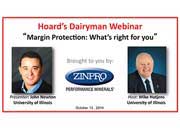 The recent Farm Bill eliminates the Milk Income Loss Contract (MILC) and replaces it with a Margin Protection Program (MPP-Dairy). "The previous program was not an adequate safety net for the U.S. dairy industry's dynamics," remarked John Newton from the University of Illinois. With MILC only a portion of the U.S. milk supply was covered. With MPP-Dairy, all milk produced is eligible to be covered, although producers have the option to participate or not, as the program is voluntary.
The recent Farm Bill eliminates the Milk Income Loss Contract (MILC) and replaces it with a Margin Protection Program (MPP-Dairy). "The previous program was not an adequate safety net for the U.S. dairy industry's dynamics," remarked John Newton from the University of Illinois. With MILC only a portion of the U.S. milk supply was covered. With MPP-Dairy, all milk produced is eligible to be covered, although producers have the option to participate or not, as the program is voluntary.Those were among the many concepts the former USDA ag economist presented during the October webinar, "Margin Protection: What's right for you?" He gave an overview of the program and then proceeded to demonstrate the USDA-provided tool that helps producers determine the level of margin insurance protection they are comfortable with. With 61 percent of the Monday webinar attendees previously not using any risk management programs, Newton's goal was to familiarize attendees with their options.
When you opt-in, you determine the level of production (how many pounds of milk you want to insure as a percent of your annual production). This level is between 25 and 90 percent. The program is adoptable to all farm sizes, with no bias on cow numbers and no cap on milk production.
The next step is to select the amount of protection you are willing to purchase, between $4.50 and $8.00/cwt. (Any producer signing up automatically is enrolled at the $4 level.) The difference between milk income (national average) and feed cost (national index consisting of 49 percent corn, 27 percent soybean meal and 24 percent alfalfa hay) determines the program's "calculated margin."
When that level is wide, profitability is high. However, when milk prices are low and feed cost rises, margins shrink. And, that is where MPP-Dairy comes into play.
If you sign up and pay the basic enrollment fee of $100, the milk-to-feed price difference is automatically covered up to $4. Four dollars is not a lot of protection, but it is some level of financial recuperation if catastrophic events impact milk or feed prices. If you chose to pay for additional insurance, there is an added cost for each level. It depends on how much risk you are comfortable with. The amount can be raised in 50-cent increments.
The most intriguing feature about the MPP-Dairy tool is the ability of the user to go back in time and see how margin protection would have buffered 2009's challenging economy. What levels of MPP-Dairy would have helped you weather the storm? More protection does not necessarily generate more net return. The trends over the past few years are all available in easy-to-follow charts. While the past cannot definitely predict the future, it's the best predicting option we have available. Try it at fsa.usda.gov/mpptool.
The last day to take signed paperwork to your Farm Service Agency (FSA) office is November 28, 2014. (recently updated to December 5, 2014) By using the MPP-tool, only a few clicks can get your form completed. Type in your farm name, last year's annual milk production, milk portion insured, amount of protection, print and sign your name. Take it to FSA and you are registered for MPP-Dairy. Quick and easy!
Once the program begins, you make two insurance payments to the program. And payments made back to the producer are made bi-monthly if your farm's margin price is triggered in the previous two months.
The data you provide is not archived and cannot be seen by others. No record is kept and privacy is paramount. The tool is an informative resource and not a database.
The October presentation was brought to you by Zinpro Performance Minerals (www.Zinpro.com/dairy) This October webinar is archived and available for viewing. Past webinars can be found at www.hoards.com/webinars.
Webinars, Economics or Dairy Management follow these links.

The author is the online media manager and is responsible for the website, webinars and social media. A graduate of Modesto Junior College and Fresno State, she was raised on a California dairy and frequently blogs on youth programs and consumer issues.








